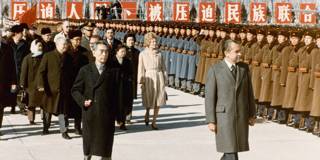Fifty years ago, the United States responded to the Sino-Soviet split with a foreign policy that was creative in both design and execution. Given the current poor state of Sino-American relations, the best way to mark the anniversary is by crafting an equally imaginative approach to reviving bilateral cooperation.
NEW YORK – The United States and China are this month marking the golden anniversary of their modern relationship. In February 1972, US President Richard Nixon and his national security adviser, Henry Kissinger, stepped off a plane in Beijing, and shortly afterward met with Communist Party of China Chairman Mao Zedong. Their visit triggered a geopolitical earthquake, what Nixon referred to as “the week that changed the world.”

NEW YORK – The United States and China are this month marking the golden anniversary of their modern relationship. In February 1972, US President Richard Nixon and his national security adviser, Henry Kissinger, stepped off a plane in Beijing, and shortly afterward met with Communist Party of China Chairman Mao Zedong. Their visit triggered a geopolitical earthquake, what Nixon referred to as “the week that changed the world.”